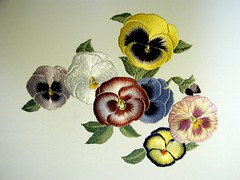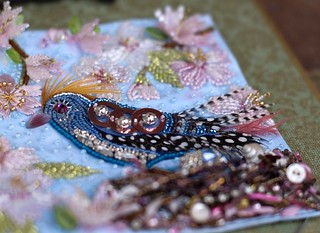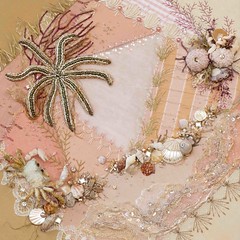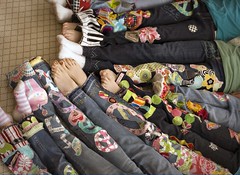I've been using my Book of Needles for almost a full year now.
In that time, this book has been my constant companion, my reliable friend, my #1 can't-do-without sewing tool, my nécessaire...

I'm rarely without it. And it's held up beautifully.
I made it last year in honor of Hari-Kuyo or the Festival of Broken Needles which occurs every year on February 8 in Japan. You can see the original post here.
Each February 8, the sewers and kimono makers of Japan will go to a shrine, taking with them their broken needles and pins that have served them in the prior year. (Hari means "needle" and kuyo means "memorial service".) The needles/pins are placed into tofu or konnyaku. The act of placing them in soft tofu serves to soothe the needles after their many hours of sewing.
The Japanese believe that all things have a spiritual essence and they have a great respect for the objects used in their daily life. It is important to respect the objects' service and not be overly wasteful by thoughtlessly tossing them away. In addition to sewing needles, I've heard of rituals for disposing of calligraphy brushes, broken combs and other tools used by craftsmen.

In preparation for next week's Hari-Kuyo, I've been working hard behind-the-scenes designing and sourcing materials in order to offer an e-course, pattern and supplies for making your own Book of Needles.



I love the different pages for the different types of needles...they keep me organized so I can quickly find the right needle for the right job. And I love love love that it feels like a real "book" with lots of fun details hidden inside.
I made it last year in honor of Hari-Kuyo or the Festival of Broken Needles which occurs every year on February 8 in Japan. You can see the original post here.
Each February 8, the sewers and kimono makers of Japan will go to a shrine, taking with them their broken needles and pins that have served them in the prior year. (Hari means "needle" and kuyo means "memorial service".) The needles/pins are placed into tofu or konnyaku. The act of placing them in soft tofu serves to soothe the needles after their many hours of sewing.
The women bring their needles to their final resting place, thank the needles for their service, and pray that the needles' power and energy will stay with them and help to improve their sewing skills in the coming year.
The Japanese believe that all things have a spiritual essence and they have a great respect for the objects used in their daily life. It is important to respect the objects' service and not be overly wasteful by thoughtlessly tossing them away. In addition to sewing needles, I've heard of rituals for disposing of calligraphy brushes, broken combs and other tools used by craftsmen.
Last year when I made my Book of Needles, I created an intermediary rest stop for the needles that I break throughout the year in the back of my book. You can see that I've gathered quite a few...

waiting to be properly laid to rest on Hari-Kuyo matsuri, next Wednesday, February 8.
There's a lot more to the tradition which is better explained in this beautiful self-published pamphlet. It's worth a read.
There's a lot more to the tradition which is better explained in this beautiful self-published pamphlet. It's worth a read.
In preparation for next week's Hari-Kuyo, I've been working hard behind-the-scenes designing and sourcing materials in order to offer an e-course, pattern and supplies for making your own Book of Needles.

I have a group of friends who are participating in a pilot class and so far I am thrilled with the books they are making and the feedback they are giving me. It's very exciting to see it all come to life.

They'll finish them on Saturday so I'll share more after that.
But this is just a teaser...stay tuned until next week when all will be revealed.
And have a very Happy Monday.





















36 comments:
I would love to participate in your e-course on the needle book-it is so lovely!
How lovely!
Craftsmen can get very attached to their tools, so Hari-kuyo doesn't seem a particularly strange idea, does it?
What a beautiful needle book!
I've been meaning to make my own for ages, but never seem to get around to it. Part of it has probably been that I've not been sure how I wanted to do it.
What a wonderful little needle book! I love having needle books nearby when stitching.
I think it is a great idea to separate the needles into groups. I have started off with the best intentions but somehow they all seem to get muddled as the year goes on. An e-course on your book might lead me down the path of organisation.Look forward to future posts.
What a beautiful thought - putting your needles and pins to rest.
And and e-course sounds lovely! Looking forward to hearing more about that!
As I've journeyed a little farther into the stitchy life, a needle book like yours seems more and more useful! Is there any chance of a student discount on the e-course?
I love your needle book. I enjoy your stories that go along with your pictures. I wanted to let you know that I used an old idea you blogged about awhile ago. Your "Money Tree" you made for your niece. I thought that was a great idea and remembered it. My version was to take a Styrofoam wig head and cover with money for my sister who just passed her the state exam to be a hairstylist. I even put fake eyelashes on it.It turned out great. Thanks for the idea. Marjorie
I can't wait for more info on the class. I do love your book and remember your post from last year.
I love the part where they are labeled. Mine are all helter kelter in my needle book... but I would have to add the category "bent" I'm always looking for the bent needles because they fit my hand...
The respect for broken needles is touching and can I take the ae-course.... Hugs Gerry Krueger.
oh, don't go giving me great ideas and offering an e-course! I've already got too much to do, and this is *tempting* !
I love your book and can't wait for your e-course!
This is a really cool idea! Awesome!
This is a beautiful concept - to show gratitude for the things that serve us and are mostly forgotten. I look forward to seeing what you and your students come up with.
I will be at my monthly Embroiderer's Guild meeting on Feb 8 (very appropriately) so I will be holding my annual needle cleaning and arrangeing cerimony of Feb 7. I loved your needle book last year and am thrilled that you will be conducting an e-course this year. I still have not made a needle book - can you believe that! I have a busy week or two ahead, but if I can find the time, I plan to make a needle keeper this year.
Love your needle book. I will never throw a needle away again and not think of your post and give them the respect they deserve.
What a great follow-up to last year's interesting post. And what a great way to keep track of those elusive needles and remember which is which! (Love those scissors; I can't resist those cuties.)
This sounds like some fun! I cannot wait to hear more about your e-class. I so need a new needle book. I love the idea of Hari-kuyo. . .
Oh yes, I remember this from last year! Love the page honoring the broken and worn needles!
I LOVED your post on Hari-kuyo last year and had planned to mention it this year on my blog, or at the very least put a link back to your beautiful post. Can't wait to hear more about your course. Although I have a number of needle books, I just might have to make another along with you!
I really should create a needle book to keep my needles organized. Love the teaser.
Oh Susan...I have loved your needle case since you shared it last year. I will definitely be looking forward to your e-course.
I loved reading this post. I broke my very first beading needle this month, and it really did feel like I was saying good-bye to an old friend. I didn't want to just throw it away -- it seemed disrespectful.
Also, I'm incredibly excited about the needle book. It's pretty and functional!
Oh what a fabulous idea!! How did I miss this last year??? HMMMMM Would love to do the e-course when you are ready to offer it! such fun!!
Ils sont magnifiques ! J'aime bien avec toutes ces couleurs. Bisous et bonne journée
ohhhh I remember you doing that ... and love the tales behind it ... good luck with it all and look forward to seeing the details etc :) love mouse xxxxx
Your needle book is beautifully crafted and I found myself wanting to make one as I was drawn deeper into your description of it. So, it was thrilling to learn that you will offer this as an e-course. Sign me up!
I started using a needle case years ago when a class I took required a "a ton" of needles and I never gave it up. Its and EGA one made of paper. It is falling apart and I would love to make a new one!!
I cannot wait to sign up!
Ohh, can't wait!!!
Thank you for the fascinating story about the Festival of Broken Needles.
This is a beautiful tradition!
Kim
http://loopsoflavender.blogspot.com/
This is a beautiful tradition!
Kim
http://loopsoflavender.blogspot.com/
Your needle book is excellent, it is exactly what I need!! I'm looking forward to your e-course!!!
OMG I can't wait! I want to make one too!
I think the Japanese are on to something. I like to tell objects that I thank them for working for me. Especially at work where our machines make or break us (I work in a hospital lab). It 's similar to American Indians thanking the plants and animals for their life to feed and clothe them. Something to think about.
Hi Susan, Found you via littledogsonlongleashes. What a fascinating entry. I am not a seamstress, but love to crochet. Over the course of many years, I've managed to break a few crochet hooks and love the idea of paying my respects for their work well-done. Thanks for sharing.
Post a Comment